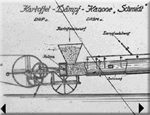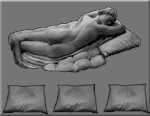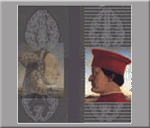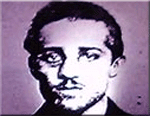| ||||||
| ||||||
| Michiel Knaven | ||
|
Looking at Michiel Knaven's portfolio , one sees that he is involved in a wide range of arts and media, from the making of artists' books to photography, "boxes and assemblages," CD ROMs, and net art. And the net art and sound art he has online reflect that diversity as well. Many artists who get involved in net art and were previously involved in other practices end up stopping all but the net practice. But Michiel hasn't. And much of his net.work continues to be informed by the "scissors and glue" he mentions in the interview below. It seems, then, that whether he ends up making something for the net or something for a gallery (or whatever) depends on the materials and the form. His approach to multimedia is quite broad. His Soundboxes have an interesting way of treating sound as object. The first one, "comic", is a simple generative music piece. The sounds you hear are triggered by collisions of the moving objects. In particular, the collisions with the circle are key to the generative music. Whether the music is taken from cartoons or not, the resulting collision-music has a 'cartoon music' feel to it. Perhaps that is part of the point of the piece: even if the music were not taken from cartoon music, there is probably bound to be an element of comedic mishap to music based on collision detection. And the collision, if not its algorithmic detection, seems to have an important place in cartoons; characters do not so much meet as collide, generally, like the plot lines in comedy. Another of the Soundboxes called "watch me" develops that 'cartoon music' theme more. And a different one called "kartoffel dampf kanone 'schmidt'" further humorously develops the exploration of sonic generation via collision detection. We also see other types of fruitful collisions in Michiel's work. In Conversations with FRANCESCA, high art collides with audio from TV soap operas. But, more generally, we see in Michiel Knaven's work a fine sense of how idea emerges from material. As though he were a writer but with material objects instead of words. Perhaps this means he has an interesting sense of composition and the language of material objects and their relations. His broad sense of multimedia, through netart and beyond, is involved here. It's interesting to compare the iconography of Knaven, Stanza, and Strasser. Knaven is more inclined to use cut-out art objects than either of the other two, for instance. But, more generally, there is a sense of the physicality of his practice, even in the digital, and the emergence of ideas from physical, animated things. Michiel Knaven lives in Zwolle, Holland. His site is michaelmedia.org.
|
||
| Interview | ||
|
Andrews
|
What drew you initially to producing art for the Web? When did you start? | |
|
Knaven
|
I bought a PC in the beginning of the nineties to find out what it would mean for my (photographic) work. Used it the first time to create an artist book (nachtmusik) although the music tape that accompanied the book was made with a simple cassette recorder. In 1995 I got an internet connection and started to build a first web site and experimented with sound and image (no longer on-line). It felt like coming home, if you look at my background; music, visual arts and a “heavy reader”, this seems natural. Always have been interested in the so called “gesamtkunstwerk”, like Scriabin. In exhibitions and in the series A Polyphonic Chronicle I tried to find ways to use music forms like the sonata, polyphony or the passacaglia to give structure. Although music forms deal with time, their inner structures like repeating and variation, helped me to think in a different way about visual works and exhibitions. And not to forget John Cage, I think of him as one of my dearest teachers. [never met him though :-( ] | |
|
Andrews
|
Do you see yourself as a net.artist? What does that term mean to you? Do you distinguish it from 'web.artist'? | |
|
Knaven
|
No not specificly, I consider netart as a form that suits my needs for the things I want to tell. Netart is just one of the new forms used in newmedia art. For me it makes no difference working in real or working for the net, it all depends on the subject and the appropriate form. But as a form it's fascinating. In my view it's the new way of creating artists' books, it has relations with that form of art like the way you view it: 1 to 1, intimately. New component is sound. Using the label netartist is a good way to promote the medium. So I don't mind if people call me netartist. (they also call me photographer, violinist, visualartist, soundartist..:-) what's in a name) | |
|
Andrews
|
Do you surf the work of other people much? If so, where do you get your links? What do you look for? | |
|
Knaven
|
Yes I do. I want to follow what's happening in netartland. And I want to share it, that's why I started MICHEL***, my netartguide. Now MICHEL is running quite well, I get a lot of links from visitors. But I also use resources like Rhizome and tips from friends. | |
|
Andrews
|
What media and arts do you see your work in relation to? | |
|
Knaven
|
visual arts like photography, film, installations, assemblage/collage, artist's books. | |
|
Andrews
|
What tools do you use? | |
|
Knaven
|
Macromedia director, photoshop, soundforge,hotdog, digitalcamera, minidiskrecorder, a pair of scissors and glue | |
|
Andrews
|
Do you consider yourself a competant programmer? Is that important to you? | |
|
Knaven
|
I manage now a days to get it programmed the way I want, but I don't consider it as an important skill. On the other hand it forces me to think about the things I want to make in a different way, your idea reduced to if-then statements which is sometimes very refreshing. | |
|
Andrews
|
What should a web.artist know? Apart from themselves and others. I am asking you how you see the role of technical knowledge in web.art. Is it necessary? What is necessary? | |
|
Knaven
|
Start blank and choose what technical knowledge you need depending on what you want to create. For me that's the only rule that counts!!! When I compare it with photography, you can start with learning everything about apertures, develop times etc etc. But then you still don't have a good picture because the quality of the image depends not on technical things but on your personal view and perception! | |
|
Andrews
|
Do you think you've grown as an artist over the last few years? Howso? | |
|
Knaven
|
Yes I think so. Difficult to see in your own work but I have the feeling that since the soundboxes and "Conversations with Fransesca" the form in relation to the content is getting more clear. I'm getting closer to the "images in my head" | |




